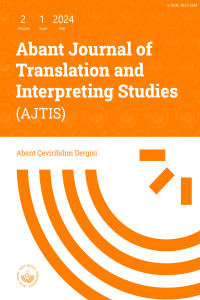Abstract
References
- Ardakani, M.P., Lashkarian,A. & Sadeghzadeh, M. (2015). The translatability/untranslatability of poetics: Eliot's "Ash Wednesday" and its two Persian translations. Iranian Journal of Social Sciences and Humanities Research, 3(1), 57-64. DOI: https://doi.org/10.24200/jsshr.vol3iss01pp57-64
- Bassnet, S. (1988). Translation studies. Routledge.
- Catford, J. C. (1965). A linguistic theory of translation: An essay in applied linguistics. Oxford University Press.
- Danielson, E. (2000). The importance of nursery rhymes. https://files.eric.ed.gov/fulltext/ED442117.pdf
- Hatim, B., & Mason, I. (1990). Discourse and the translator. Longman.
- Jackson, R. (2011, March). Translation, adaptation and transformation: The poet as translator. Numéro Cinq, 2(3), 1-6. http://numerocinqmagazine.com/
- Jones, F. R. (2011a). Poetry translation. In Y. Gambier, & L. van Doorslaer (Eds.), Handbook of translation studies (pp. 117-122). John Benjamins Publishing Company.
- Jones, F. R. (2011b). The translation of poetry. In K. Malmkjær, & K. Windle (Eds.), The Oxford handbook of translation studies (pp. 169-182). Oxford University Press.
- Jones, F. R. (1989). On aboriginal sufferance: A process model of poetry translating. Target,1(2), 183-199. Amsterdam & Philadelphia: John Benjamin Publishing Company. http://dx.doi.org/10.1075/target.1.2.04jon
- Lefevere, A. (1975). Translating poetry: Seven strategies and a blueprint. Van Gorcum.
- Munday, J. (2001). Introducing translation studies. Routledge.
- Newmark, P. (1981). Approaches to translation. Pergamon Press.
- Nida, E. A. (1964). Toward a science of translating: With special reference to principles and procedures involved in Bible translating. E. J. Brill.
- Nida, E. A., & Taber, R. (1982). The theory and practice of translation. E. J. Brill
- Nouss, A. (2011). Review of the book: Second finding. A poetics of translation, by B. Folkart. Target, 23(2), 353-363. http://dx.doi.org/10.1075/target.23.2.10nou
- Pratama, I. D. (2017). Meaning and form in nursery rhymes translation. Humanus: Jurnal Ilmiah Ilmu-Ilmu Humaniora, 16(1), 1-12. https://doi.org/10.24036/jh.v16i1.6655
- Vinay, J. P., & Darbelnet, J. (2000). A methodology for translation (J. C. Sager, & M. J. Hamel, Trans.). In L. Venuti (Ed.), The translation studies reader (pp. 84-95). Routledge.
Translating Nursery Rhymes from Sinhalese to English: With Special Reference to the Translation Strategies
Abstract
This study delves into the significant role nursery rhymes play in children's development and focuses on the challenges faced by novice translators in rendering these verses into another language. The research aligns itself with Jones's (1989) conceptual framework, which delineates four levels of poetry translation: literal translation, approximation, adaptation, and imitation. These levels guide the exploration of the translation practices employed by novice translators. The investigation reveals that novice translators predominantly resort to literal translation and adaptation when tackling nursery rhymes. Literal translation involves a direct conversion of the source text, maintaining a word-for-word correspondence, while adaptation entails modifying the content to suit the cultural and linguistic context of the target language while preserving the essence of the original rhyme. The prevalence of these two strategies suggests that novice translators find it convenient either to adhere closely to the literal meaning of the source material or to creatively adapt it to fit the linguistic and cultural nuances of the target language. Understanding the challenges faced by novice translators in the translation of nursery rhymes is crucial for enhancing the quality of translated materials aimed at children. This research contributes to the broader discourse on translation strategies, shedding light on the specific nuances involved in the translation of poetic and culturally significant content for young audiences.
References
- Ardakani, M.P., Lashkarian,A. & Sadeghzadeh, M. (2015). The translatability/untranslatability of poetics: Eliot's "Ash Wednesday" and its two Persian translations. Iranian Journal of Social Sciences and Humanities Research, 3(1), 57-64. DOI: https://doi.org/10.24200/jsshr.vol3iss01pp57-64
- Bassnet, S. (1988). Translation studies. Routledge.
- Catford, J. C. (1965). A linguistic theory of translation: An essay in applied linguistics. Oxford University Press.
- Danielson, E. (2000). The importance of nursery rhymes. https://files.eric.ed.gov/fulltext/ED442117.pdf
- Hatim, B., & Mason, I. (1990). Discourse and the translator. Longman.
- Jackson, R. (2011, March). Translation, adaptation and transformation: The poet as translator. Numéro Cinq, 2(3), 1-6. http://numerocinqmagazine.com/
- Jones, F. R. (2011a). Poetry translation. In Y. Gambier, & L. van Doorslaer (Eds.), Handbook of translation studies (pp. 117-122). John Benjamins Publishing Company.
- Jones, F. R. (2011b). The translation of poetry. In K. Malmkjær, & K. Windle (Eds.), The Oxford handbook of translation studies (pp. 169-182). Oxford University Press.
- Jones, F. R. (1989). On aboriginal sufferance: A process model of poetry translating. Target,1(2), 183-199. Amsterdam & Philadelphia: John Benjamin Publishing Company. http://dx.doi.org/10.1075/target.1.2.04jon
- Lefevere, A. (1975). Translating poetry: Seven strategies and a blueprint. Van Gorcum.
- Munday, J. (2001). Introducing translation studies. Routledge.
- Newmark, P. (1981). Approaches to translation. Pergamon Press.
- Nida, E. A. (1964). Toward a science of translating: With special reference to principles and procedures involved in Bible translating. E. J. Brill.
- Nida, E. A., & Taber, R. (1982). The theory and practice of translation. E. J. Brill
- Nouss, A. (2011). Review of the book: Second finding. A poetics of translation, by B. Folkart. Target, 23(2), 353-363. http://dx.doi.org/10.1075/target.23.2.10nou
- Pratama, I. D. (2017). Meaning and form in nursery rhymes translation. Humanus: Jurnal Ilmiah Ilmu-Ilmu Humaniora, 16(1), 1-12. https://doi.org/10.24036/jh.v16i1.6655
- Vinay, J. P., & Darbelnet, J. (2000). A methodology for translation (J. C. Sager, & M. J. Hamel, Trans.). In L. Venuti (Ed.), The translation studies reader (pp. 84-95). Routledge.
Details
| Primary Language | English |
|---|---|
| Subjects | Translation and Interpretation Studies |
| Journal Section | Research Articles |
| Authors | |
| Publication Date | February 29, 2024 |
| Submission Date | January 19, 2024 |
| Acceptance Date | February 29, 2024 |
| Published in Issue | Year 2024 Volume: 2 Issue: 1 |


